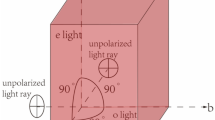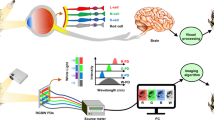Abstract
IN one of the first papers1 on the phenomenon of sensitization of photographic plates to the long-wave rays of the spectrum by dyestuffs, Vogel noted that the maximum sensitivity is often shifted by several hundred Angstrom units towards the red in comparison with the maximum absorption of the dye-stuffs in solution. The usually accepted explanation2 of this phenomenon is that it is due to the displacement of the maximum of absorption of the dye-stuff by its adsorption on the silver halide. But on account of the difficulties connected with measuring the absorption by scattering media, this hypothesis has not yet been confirmed experimentally.
This is a preview of subscription content, access via your institution
Access options
Subscribe to this journal
Receive 51 print issues and online access
$199.00 per year
only $3.90 per issue
Buy this article
- Purchase on Springer Link
- Instant access to full article PDF
Prices may be subject to local taxes which are calculated during checkout
Similar content being viewed by others
References
Vogel, H., Ber. deut. chem. Ges., 7, 976 (1874).
Bonhoeffer, K., and Harteck, P., “Grundlagen der Photochemie” (Dresden und Leipzig: Th. Steinkopff, 1933), p. 278.
de Boer, J. H., Z. physik. Chem., B, 15, 281 (1932).
Author information
Authors and Affiliations
Rights and permissions
About this article
Cite this article
NATANSON, S. Position of Maximum Optical Sensitivity of Sensitized Photographic Plates. Nature 140, 197–198 (1937). https://doi.org/10.1038/140197b0
Issue Date:
DOI: https://doi.org/10.1038/140197b0
Comments
By submitting a comment you agree to abide by our Terms and Community Guidelines. If you find something abusive or that does not comply with our terms or guidelines please flag it as inappropriate.



